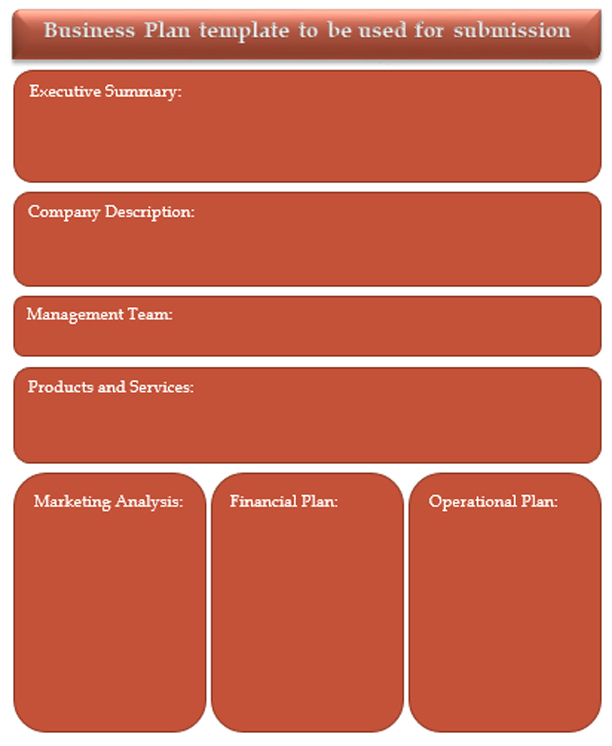A
business plan is the basic foundation of any business, it is widely used to pitch your idea to the team to join in as a partner, cofounder or investor, it is also used to various financial institutions for funding and loans, and it is the most critical element to showcase your business model, your thought process and ability to present it and your strengths and your teams capabilities to deliver it effectively and efficiently to gain the confidence of the investor to put money in your idea and easily take the risk with you.
 Remember “It is not the business idea or the plan that sells, it is your confidence and your teams commitment that gain you funding”
Remember “It is not the business idea or the plan that sells, it is your confidence and your teams commitment that gain you funding”
The world-renowned single page business plan template helps you narrow down your thoughts to single objective, single problem and solution all in one pager document that can be used for all purposes. This is fastest way to showcase your idea without being caught in the detailed descriptions of every aspect of your plan. This is something that comes naturally to you when you first thought of the idea and if keeping it simple can solve the purpose, why not stay on one single page and define clearly what we are thinking about this idea or business. It is similar to using a huge hoarding but putting your words in a single line for your best marketing campaign, can’t the marketers fill the entire hoarding with all the features and benefits of the product on display…?
This is very focused on the target items without overwhelming the reader. In simplest terms it talks about the problem and solution for the target market through the business model with details of the existing competition, financial projections and finding requirement.
These are well thought after elements for your business model, just need to be precise, clear and on target while writing them on a single pager document in smmary form.
For the purpose of our Idea Meet and IDEATHONS We have the section details given in the later part of this document, the elements as shown in this image are seven viz:
Executive Summary, then we have company description, then management team and organization, after that we need market analysis of the product and services, then we need to fill marketing and sales strategies.
After these we enter into the finance area and need to fill the details of the project finances, the seed funds, their allocation, financial plans for three to five years is good and the funding requirement along with the big moves. We also need the operations plan and you can also share the other details in an appendix sheet.


This is the power of short and precise information, and this is the only means to showcase your idea to maximum number of investors because nobody has time and bandwidth to flip pages to read what you want to say, this way a single page business plan template is by far the most popular and powerful tool used by all entrepreneurs and start-up. We are taught in schools to compress our writing and say only a few words for explaining something, be it a telegram writing, short note or advertisement. We just need to learn and practice compressing our words to fit in a single page without killing the essence of message.
Here are the key elements of a business plan template:
- Executive summary: talks about your business (idea, Vision, problem, solution)
- Company description: talks about you, your market, approach, your strengths, and methodology.
- Management team: Your core strength as a team, diversity and utility.
- Product/Service: talks about your USP, Stage of development, competitive advantage, IPR etc.
- Market analysis: Opportunity, its size, geography, drivers to change, and competitors.
- Financial plan: Route to market, entry barriers, prices, projected sales, returns, break even.
- Operational plan: How to operate, teams, geographies, funding milestones and pivot.
Understanding the elements of Business plan template in detail:
A business plan is a written document that outlines a company’s objectives, strategies, and tactics for achieving those objectives. Business plans are typically used by entrepreneurs and business owners to secure funding from investors or loans from banks. A business plan template can help guide the writing process and ensure that all essential elements are included. The following are the key elements of a typical business plan template:
1. Executive summary: This is a brief overview of the business plan that summarizes the company’s purpose, goals, and strategies. The executive summary should be compelling and grab the reader’s attention. It is although the first section of the plan but it is written in the end after all the other sections are completed. The purpose of the executive summary is to provide the reader with a high level view of the business or project, highlighting the key points and main objectives.
In an executive summary it is important to include:
- The purpose of the business or project, or project.
- The unique value preposition or competitive advantage.
- The target market and customer demographics.
- Financial projections and funding needs.
- Management team and key personnel.
- Milestones and timelines for achieving goals.
The executive summary should be clear, concise and engaging. It should be written in a way that captures the reader’s attention and encourages them to read the entire business plan or proposal. The goal of the executive summary is to provide a quick overview of the business or project to convince the reader that its worth investing time and resources into.
2. Company description: This section provides detailed information about the company, including its history, mission statement, products or services, target market, and unique selling proposition.

A company description is an essential component of a business plan that provides an overview of the company, its products or services, and its mission and goals. It is a summary of the key information about the company that helps the reader understand what the company does, what makes it unique, and what it hopes to achieve.
In a company description, it’s important to include:
- Company name, location, and legal structure
- Brief history of the company and its founders
- Products or services offered by the company
- Target market and customer demographics
- Competitive advantage or unique selling proposition
- Mission statement and company values
The company description should be written in a clear and concise manner, highlighting the most important aspects of the company. It should provide enough information to give the reader a sense of what the company is all about, but not so much that it becomes overwhelming or difficult to read. The goal of the company description is to provide a compelling overview of the company that sets the stage for the rest of the business plan.
3. Management and organization: This section describes the company’s management team and organizational structure, including the roles and responsibilities of each team member.
The management and organization section of a business plan outlines the structure of the company’s management team, their responsibilities, and the overall organization of the company. It is important because it shows the reader who is responsible for managing the company and how they will work together to achieve its goals.
In the management and organization section, it’s important to include:
- Management team: A description of the company’s management team, their roles and responsibilities, and their relevant experience.
- Organizational structure: A diagram or description of the company’s organizational structure, including any departments or teams.
- Board of directors or advisors: A list of the company’s board of directors or advisors, their roles and responsibilities, and their relevant experience.
- Key personnel: A list of the company’s key personnel, including their roles and responsibilities, and their relevant experience.
- Ownership structure: A description of the company’s ownership structure, including any investors or shareholders.
- Management philosophy: A statement about the company’s management philosophy, including its approach to leadership, decision-making, and employee empowerment.
The management and organization section should be clear and concise, and should demonstrate that the company has a strong and experienced management team in place. It should also show that the company has a clear and well-defined organizational structure that will enable it to achieve its goals. The goal of the management and organization section is to instill confidence in the reader that the company is well-managed and has the necessary resources to succeed.
4. Market analysis of Product or Services: This section includes research and analysis of the company’s industry, competitors, target market, and market trends. This information can help the company identify opportunities and challenges in the marketplace.
A market analysis is a section of a business plan that provides an overview of the industry and market in which the company operates. It helps the reader understand the company’s competition, target market, and the overall business landscape. A market analysis is important because it can help the company identify opportunities and threats in the marketplace, and develop strategies to capitalize on those opportunities and mitigate the threats.
In a market analysis, it’s important to include:
- Industry overview: A summary of the industry in which the company operates, including size, growth rate, and major players.
- Market segmentation: A description of the target market, including demographics, psychographics, and purchasing behavior.
- Competitor analysis: An assessment of the company’s competitors, including their strengths and weaknesses, market share, and pricing strategies.
- Market trends: An analysis of the market trends and changes, such as new products, emerging technologies, or shifts in consumer behavior.
- Barriers to entry: A description of any obstacles or challenges that the company may face when entering the market.
- Regulatory environment: An overview of the laws and regulations that govern the industry.
The market analysis should be based on current and reliable data, and should be presented in a clear and concise manner. The goal of the market analysis is to provide a comprehensive understanding of the industry and market, and to help the company make informed decisions about its marketing and sales strategies.
5. Marketing and sales strategies: This section
outlines the company’s marketing and sales plans, including pricing strategies, promotion tactics, and distribution channels.
Marketing and sales strategies are an essential part of a business plan that outline how the company will promote and sell its products or services to its target market. These strategies are important because they help the

company identify its target customers, understand their needs and preferences, and develop effective tactics to reach and persuade them to buy.
In marketing and sales strategies, it’s important to include:
- Product or service positioning: How the company’s products or services are positioned in the market, and how they differentiate from competitors.
- Pricing strategy: How the company will price its products or services, including any discounts or promotions.
- Distribution channels: The channels through which the company will distribute its products or services to the target market, such as online sales, retail stores, or wholesalers.
- Promotional tactics: The marketing and advertising tactics the company will use to promote its products or services, such as social media advertising, print advertising, or email marketing.
- Sales approach: The sales approach the company will use to sell its products or services, such as direct sales, inside sales, or channel sales.
- Customer relationship management: How the company will manage and maintain relationships with its customers, such as customer service or loyalty programs.
The marketing and sales strategies should be based on the market analysis, and should be tailored to the specific needs and preferences of the target market. They should be realistic and achievable, and should be backed by a clear action plan and budget. The goal of the marketing and sales strategies is to help the company generate revenue and grow its customer base.
6. Financial projections: This section includes financial projections such as income statements, cash flow statements, and balance sheets, as well as assumptions and risks associated with the financial projections.
The financial projections section of a business plan outlines the expected financial performance of the company over a certain period of time, typically three to five years. It is an essential component of a business plan because it helps the reader understand the financial viability of the company and the potential return on investment for investors.
In the financial projections section, it’s important to include:
- Income statement: A projected income statement that shows the company’s expected revenue, cost of goods sold, gross profit, operating expenses, and net income.
- Balance sheet: A projected balance sheet that shows the company’s expected assets, liabilities, and equity over the period covered by the plan.
- Cash flow statement: A projected cash flow statement that shows the company’s expected cash inflows and outflows over the period covered by the plan.
- Break-even analysis: An analysis of the company’s break-even point, which is the level of sales needed to cover all of its expenses.
- Assumptions and methodology: A description of the assumptions and methodology used to develop the financial projections, including any research or analysis conducted to support them.
- Financial ratios: Key financial ratios that show the company’s financial health, such as profitability, liquidity, and solvency ratios.
The financial projections should be based on realistic assumptions and should be supported by data and research. They should also be presented in a clear and concise manner, with graphs and charts used to help illustrate the key points. The goal of the financial projections section is to demonstrate the financial viability of the company and to show that it has the potential to generate returns for investors.
This is the section where you can briefly explain your big moves and possible pivots for the organization and the funding pattern you can draw to support your big moves.
Here you can also add a keynote regarding your funding request in case your business plan is being used to secure funding, this section will include a detailed request for investment, along with a description of how the funds will be used.
The funding request section of a business plan outlines the amount of funding the company needs to start or grow its business, and how it plans to use the funds. This section is important because it helps the reader understand the financial needs of the company and the potential return on investment for investors.
- Funding needed: The amount of funding the company needs to start or grow its business, including a breakdown of how the funds will be used.
- Use of funds: A detailed explanation of how the funds will be used, including specific expenses such as equipment purchases, marketing expenses, or salaries.
- Expected return on investment: An explanation of the potential return on investment for investors, including projected revenues, profits, and exit strategies.
- Repayment plan: A plan for repaying any loans or investments, including the terms and conditions of the repayment plan.
- Equity offering: An explanation of any equity offering, including the amount of equity being offered and the valuation of the company.
- Financial projections: The financial projections for the company, including the income statement, balance sheet, and cash flow statement.
The funding request should be based on realistic assumptions and should be supported by data and research. It should also be presented in a clear and concise manner, with graphs and charts used to help illustrate the key points. The goal of the funding request section is to demonstrate the financial needs of the company and the potential return on investment for investors, and to persuade investors to provide the necessary funding to start or grow the business.
7. Operations Plan: This section includes Operational plan and additional information that may be relevant to the business plan, such as organizational structure, plant, assets, equipment, work flows, supply chain, support system, key deliverables, steps to growth, hiring schedules for key positions, office locations, product range expansion and so on.
An operational plan is your explanation on how you are going to deliver on the promise you have made in your executive summary and in financial projections. How you will create, produce and generate revenue and bring profitability.
The operational plan must include:
- Plant, Machinery, Equipment, Assets for starting the process
- Production workflow
- Industry association and memberships
- Supply chain>
- Quality control
- Material, production requirement, special requirement, inventory
- Feasibility analysis
- Cost analysis
- Bottom line analysis
The operational plan and Financial plans are most of the time talks about the same element of the business requirement but from the two different perspectives. For example where the financial plan simply talks about the expenditure part of acquiring a machine, the operational plan explains the feasibility and the utility of the same machine.
You may also use appendix for additional information. The appendix of a business plan is an optional section that includes any additional information that supports the main sections of the plan. It is a place to include any supplemental materials that are relevant to the business plan but not essential to its main sections.
In the appendix, it’s common to include:
Legal documents: Any legal documents related to the business, such as articles of incorporation, partnership agreements, or patents.
- Market research: Any market research or industry reports that support the market analysis section of the plan.
- Resumes and bios: Resumes and biographies of key personnel, including the management team and advisors.
- Product information: Detailed information about the company’s products or services, including technical specifications and diagrams.
- Marketing materials: Any marketing materials, such as brochures, advertisements, or social media content, that support the marketing and sales strategies section of the plan.
- Financial data: Any financial data, such as historical financial statements or projections, that support the financial projections section of the plan.
The appendix should only include materials that are directly relevant to the business plan, and should be organized in a clear and concise manner. It should also be referenced in the main sections of the plan where relevant, to help the reader understand how the materials support the plan as a whole. The goal of the appendix is to provide additional information and context that supports the main sections of the plan, and to help the reader make an informed decision about the business.
Polaris is running one of the best Incubation center in India imparting trainings and workshops on skillset enhancement to youth. Polaris work on startup ideas, the ideas those are innovative and can be developed into a real business. We work closely with young entrepreneurs while they are in their college and train them on entrepreneurship skills and motivate them to join the vision of new India with their own startups.
For more such interesting and informative articles keep sharing our page and get in touch if you are willing to launch your own startup. We at Polaris Incubation center have all necessary tools and techniques those can help you excel with your idea, get in touch in full confidence to get to the next level with your incredible business idea, we will help you get a plan and line up the execution part for you to kickstart your dream project.
Polaris Educational and Cultural Trust the parent body of Polaris Academy of Excellence and Polaris Incubation Center is running one of its kind Free SAT classes for USA college admissions in Graduation. Polaris Incubation Center is the best incubation center in Aligarh, working closely with small and regional colleges to provide them the best business incubator in Aligarh. Polaris Incubator, work on startup ideas, the ideas those are innovative and can be developed into a real business. Polaris Incubator, the first private Incubation center in Aligarh work closely with young entrepreneurs while they are in their college and train them on entrepreneurship skills and motivate them to join the vision of new India with their own startups. PAE Stack is employability and entrepreneurship development programs run by Polaris within the colleges as well as outside to make the youth of the region more employable and better placed for entrepreneurship ventures. For more details and information about the programs run by us for schools, colleges and communities please get in touch with us by subscribing to our newsletter.




